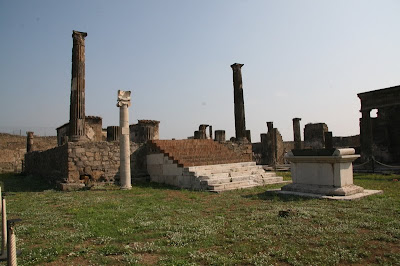 The Pompeiian Forum
The Pompeiian ForumOur first activity on site this week was an orientation tour of the scavi for newcomers. This gave us a chance to look at the forum area, an area we would also get a more detailed look at with a lecture by John Dobbins in Week 3. As such I have conbined information from both to give students and followers of the blog an overview of the forum.
For some time, scholars have argued over the nature of the forum area. many have argued that it was of an earlier Samnite construction phase within the city or Etruscan in nature. The Pompeii Forum Project under the leadership of Dobbins for many years in the 1990's worked and excavated to uncover the true nature of the forum and its use of space. The forum project's findings were somewhat revolutionary to those pumped out by excavators for many many years. The archaeological evidence which included excavation and measurement of structures and the analysis of both Roman and Etruscan units of measurement, concluded quite conclusively that the forum of Pompeii, as it was in AD79, was indeed a Roman forum. It is now suggested that after the Roman colonisation of the city they found a pre-forum type space. It was there in this space probably used for the town markets and also gatherings and meetings that the Romans added their own traditions to reorganise and further define the space into the forum that was Roman in nature. As Dobbins explained; "they made it grand and implanted their institutions and structure."
 This years visit to the forum area has a new feel to it. A feel that has not existed for 15 years. In an effort to accomodate Japanese tourists who were annoyed at the small dust whirlwinds that could be whipped up by the afternoon breezes in the forum, the SAP, 15 years ago fenced off the forum space and planted grass. This forced tourists into the outside walkways around the forum and some luxurious grass was grown and stopping those dust whirl winds. This year, as part of an attempt to reinvigorate the scavi, the fence has been removed and the space returned to the people. The forum area is again how the Roman's intended. Slowly the grass that remains is disappearing and marble paving stones that still exist can be seen.
This years visit to the forum area has a new feel to it. A feel that has not existed for 15 years. In an effort to accomodate Japanese tourists who were annoyed at the small dust whirlwinds that could be whipped up by the afternoon breezes in the forum, the SAP, 15 years ago fenced off the forum space and planted grass. This forced tourists into the outside walkways around the forum and some luxurious grass was grown and stopping those dust whirl winds. This year, as part of an attempt to reinvigorate the scavi, the fence has been removed and the space returned to the people. The forum area is again how the Roman's intended. Slowly the grass that remains is disappearing and marble paving stones that still exist can be seen.
 The oldest sanctuary/ religious space the Romans found in Pompeii was that of the Sanctuary of Apollo. Southern Italy was a part of the Greek colonial region known as Magna Graecia and Hellenistic culture had also heavily influenced some of the Italic cultures such as the Etruscans. The sanctuary was located in the oldest part of the city next to the central "forum" space. The Romans respected the religious space adding an alter in the temple area. Roman religious influence was also quickly made part of the city with the old Temple of Zeus reincarnated as the Temple to the Capitoline Triad; Jupiter, Juno and Minerva, and sat at the head of the newly restructured Roman forum area.
The oldest sanctuary/ religious space the Romans found in Pompeii was that of the Sanctuary of Apollo. Southern Italy was a part of the Greek colonial region known as Magna Graecia and Hellenistic culture had also heavily influenced some of the Italic cultures such as the Etruscans. The sanctuary was located in the oldest part of the city next to the central "forum" space. The Romans respected the religious space adding an alter in the temple area. Roman religious influence was also quickly made part of the city with the old Temple of Zeus reincarnated as the Temple to the Capitoline Triad; Jupiter, Juno and Minerva, and sat at the head of the newly restructured Roman forum area.
The Temple of Vespasian (probably earlier dedicated to Augustus) also became an important religious space within the forum.
It seems every Roman city, including Pompeii, needs to be a little Rome with a little Roman forum.
Frank Brown, architect and historian, was quoted by Dobbins as saying that the architecture of the Romans is the art of shaping space around ritual; religious (the Gods), the community and the family. All roman archiecture can be viewed in this way.
Go away now and find a map of the Roman forum. Label or become familiar with the space/ structures and their function. The forum is the civic, religious and economic centre of the city. It also supported social gatherings and events.